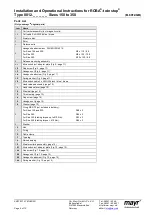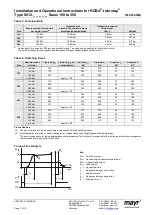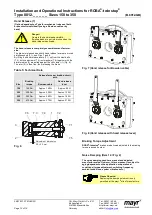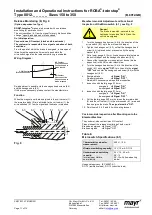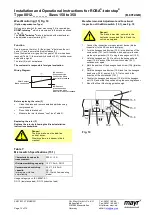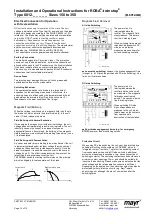
Installation and Operational Instructions for ROBA
®
-twinstop
®
Type 8012._ _ _ _ _ Sizes 150 to 350
(B.8012.GB)
05/07/2010 TK/HW/SU
Chr. Mayr GmbH + Co. KG
Tel.: 08341 / 804-0
Eichenstraße 1
Fax: 08341 / 804-421
D-87665 Mauerstetten
http://www.mayr.de
Page 14 of 15
Germany eMail:
Electrical Connection for Operation
with Overexcitation
DC current is necessary for operation of the brake.
The coil
voltage is indicated on the Type tag (14) as well as on the brake
body and is designed according to the DIN IEC 60038 (± 10 %
tolerance). The brake may only be operated with overexcitation
(e.g. with
a ROBA
®
-switch fast acting rectifier or phase
demodulator
).
Dependent on the brake equipment, the
connection possibilities can vary. Please follow the exact
connections according to the Wiring Diagram.
The manufacturer
and the user must observe the applicable directives and
standards (e.g. DIN EN 60204-1 and DIN VDE 0580).
Their observance must be guaranteed and double-checked!
Earthing Connection
The brake is designed for Protection Class I. This protection
covers not only the basic insulation, but also the connection of
all conductive parts to the PE conductor on the fixed installation.
If the basic insulation fails, no contact voltage will remain.
Please carry out a standardized inspection of the PE conductor
connections to all contactable metal parts!
Device Fuses
To protect against damage from short circuits, please add
suitable device fuses to the mains cable.
Switching Behaviour
The operational behaviour of a brake is to a large extent
dependent on the switching mode used. Furthermore, the
switching times are influenced by the temperature and the air
gap between the armature disk (2) and the coil carrier (1)
(dependent on the wear condition of the linings).
Magnetic Field Build-up
When the voltage is switched on, a magnetic field is built up in
the brake coil, which attracts the armature disk (2) to the coil
carrier (1) and releases the brake.
Field Build-up with Normal Excitation
If we energise the magnetic coil with nominal voltage, the coil
voltage does not immediately reach its nominal value. The coil
inductivity causes the current to increase slowly as an
exponential function. Accordingly, the build-up of the magnetic
field takes place more slowly and the braking torque drop (curve
1) is also delayed.
Field Build-up with Overexcitation
A quicker and safer drop in braking torque is achieved if the coil
is temporarily placed under a higher voltage than the nominal
voltage, as the current then increases more quickly. Once the
brake is released, it is possible to switch over to the nominal
voltage (curve 2). The effective capacity may however not be
larger than the nominal capacity of the coil.
The ROBA®-switch fast acting rectifier works on this principle,
which is obligatory for safe operation of this brake.
Magnetic Field Removal
AC-side Switching
The power circuit is
interrupted before the
rectifier. The magnetic field
slowly reduces. This delays
the rise in braking torque.
When switching times are not
important, please switch AC-
side, as no protective
measures are necessary for
coil and switching contacts.
⇒
⇒
⇒
⇒
Low-noise switching;
however, the brake engagement time
is longer (c. 6-10 times longer than with DC-side switching). Use
for non-critical brake times.
DC-side Switching
The power circuit is
interrupted between the
rectifier and the coil as well
as mains-side. The magnetic
field reduces extremely
quickly. This causes a quick
rise in braking torque.
When switching DC-side,
high voltage peaks are
produced in the coil, which
lead to wear on the contacts
from sparks and to
destruction of the insulation.
⇒
⇒
⇒
⇒
Short brake engagement times (e.g. for emergency
STOP);
however, louder switching noises.
Protective Circuit
When using DC-side switching, the coil must be protected by a
suitable protective circuit according to VDE 0580, which is
integrated in
mayr
®
rectifiers. To protect the switching contact
from consumption when using DC-side switching, additional
protective measures are necessary (e.g. series connection of
switching contacts). The switching contacts used should have a
minimum contact opening of 3 mm and should be suitable for
inductive load switching. Please make sure on selection that the
rated voltage and the rated operation current are sufficient.
Depending on the application, the switching contact can also be
protected by other protective circuits (e.g.
mayr
®
-spark
quenching unit), although this may of course then alter the
switching times.
F1: External fuse
Coil
S1
F1
L
N
1 2 3 4 5 6 7 8
20/017.000.2
200 - 500V~
200 - 300V~
IN
OUT
U– = 0,45×U~
+
–
S
DC
ROBA -switch
I
= 1,8A
max
–
R
R
F1: External fuse
Coil
S1
F1
L
N
1 2 3 4 5 6 7 8
20/017.000.2
200 - 500V~
200 - 300V~
IN
OUT
U– = 0,45×U~
+
–
S
DC
ROBA -switch
I
= 1,8A
max
–
R
R
1
t
1
t
2
2
I
M
Braking torque path
M
nom
I
nom
Current path
Содержание E27 Series
Страница 4: ...4 E27 Gearless Installation and maintenance 5323 en 2018 04 c...
Страница 15: ......
Страница 46: ...30 31 NOTES...
Страница 109: ......
Страница 110: ......
Страница 111: ......






